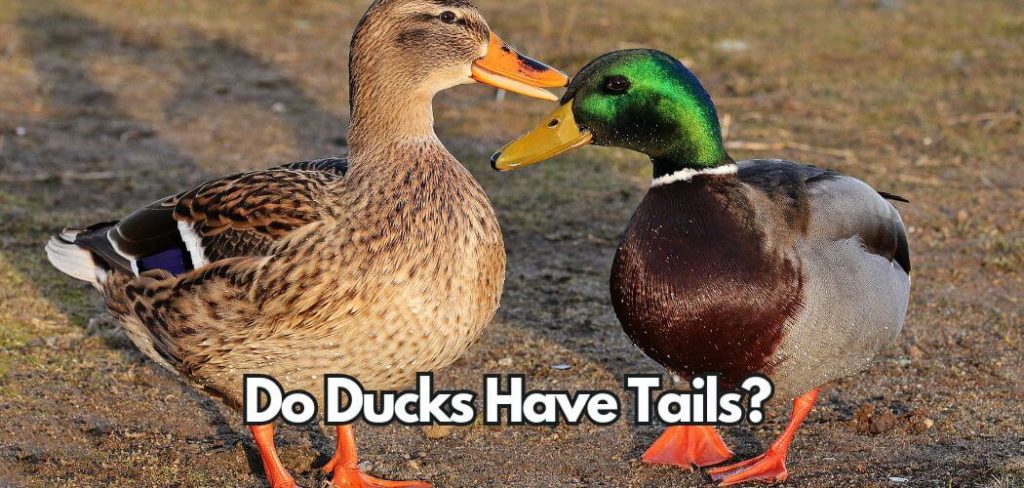Do ducks have tails? It’s a question that may seem straightforward, but the answer is not as simple as you might think.
While it may seem obvious that ducks have tails, there are several different types of ducks, and not all of them have the same kind of tail.

Do ducks have tails?
Yes, ducks have tails and their tails are an important part of their anatomy and play a crucial role in their daily activities.
Ducks have a unique tail structure that sets them apart from other birds. Their tails are short and pointed, with a distinctive curve at the end.
This shape helps ducks to maintain their balance while swimming and diving. Additionally, ducks use their tails for communication.
When ducks are feeling threatened or agitated, they will raise their tails as a warning signal to other ducks.
Conversely, when ducks feel relaxed and content, they will lower their tails as a sign of peace and calm.
It’s worth noting that not all ducks have the same type of tail. Some species, such as the Mallard, have a curly tail that is highly prized for its beauty.
Other species, like the Muscovy duck, have a more streamlined tail that helps them to fly more efficiently.
Functions of a ducks tail:
A duck’s tail serves several important functions. Here are some of the key functions of a duck’s tail:
1. Balance:
A duck’s tail helps it maintain balance while swimming. The tail acts as a rudder and helps the duck change direction quickly.
The tail also helps the duck maintain stability while diving for food or swimming in rough water.
2. Communication:
Ducks use their tails to communicate with each other. They can raise or lower their tails to signal aggression or submission.
They can also use their tails to attract mates during breeding season.
3. Flight:
While ducks are primarily known for their swimming abilities, they are also capable of flight. A duck’s tail helps it steer and control its flight.
The tail feathers act as a brake, helping the duck slow down and land safely.
4. Insulation:
Ducks have a layer of fat under their skin that helps keep them warm in cold temperatures. The feathers on their tails also help insulate them from the cold.
The feathers are tightly packed together, creating a barrier that traps warm air close to the duck’s body.
Do male and female duck’s tails differ?
Male and female ducks do have differences in their physical appearance, including their tails. The most notable difference is the length of the tail feathers.
Male ducks, also known as drakes, typically have longer tail feathers than female ducks, also known as hens.
The length of the tail feathers is an important factor in identifying the sex of a duck. In some species, such as mallards, the difference in tail length is quite noticeable.
Male mallards have long, curled tail feathers, while female mallards have a shorter and more rounded tail feathers.
Another difference between male and female duck tails is the coloration. In some species, such as wood ducks, male ducks have more vibrant and colorful plumage on their tails than females.
This is because male ducks use their colorful tails to attract females during mating season.
It’s worth noting that not all species of ducks have noticeable differences in their tail feathers. In some species, such as the northern pintail, both males and females have long, pointed tail feathers.
Why do duck tail curls?
Ducks are known for their unique curled tails, which are often used to identify different breeds of ducks. But have you ever wondered why ducks have curly tails in the first place?
The answer lies in the anatomy of ducks. Unlike most birds, ducks have a gland at the base of their tails called the uropygial gland.
This gland secretes oil that the ducks spread over their feathers to keep them waterproof and insulated. The oil also helps to keep the feathers clean and free of parasites.
The curly shape of the duck’s tail helps to distribute the oil evenly over the feathers. When a duck preens itself, it will use its beak to spread the oil from the uropygial gland over its feathers.
The curled tail feathers act as a brush, distributing the oil evenly over the rest of the feathers.
In addition to helping with preening, the curled tail feathers also play a role in courtship displays.
Male ducks will often fan out their tail feathers and perform a dance to attract females. The curled feathers create an attractive and eye-catching display that is unique to ducks.
The curly tail feathers of ducks serve an important purpose in their survival and reproduction.
They help to keep their feathers in good condition, which is essential for their ability to fly and stay warm.
They also play a role in courtship displays, which is important for the continuation of the species.
Is it all duck species that have curly tails?
It is not all duck species that have curly tails. Some duck species have straight tails, while others have slightly curved tails.
One example of a duck species with a straight tail is the mallard duck. Mallard ducks are one of the most common duck species in North America and are easily recognizable by their green head and yellow bill.
Their tail feathers are straight and do not curl up like some other duck species. On the other hand, some duck species have highly curved tails, such as the Northern pintail duck.
These ducks have a long, thin tail that curls upwards, giving them a distinctive appearance. Other duck species with curly tails include the cinnamon teal and the Northern shoveler.
It’s important to note that the shape of a duck’s tail can vary depending on the age and sex of the bird.
For example, male ducks may have more curved tails than females, while juvenile ducks may have straighter tails that curl as they mature.
Final Thoughts:
While ducks may not have the most impressive tails in the animal kingdom, their tails are still an important part of their anatomy and play a crucial role in their daily activities.
It is also worth noting that not all ducks have the same type of tail. Some species have longer tails than others, while some have more rounded or pointed tails.
This variation is due to differences in the birds’ habitats, behaviors, and evolutionary history.
